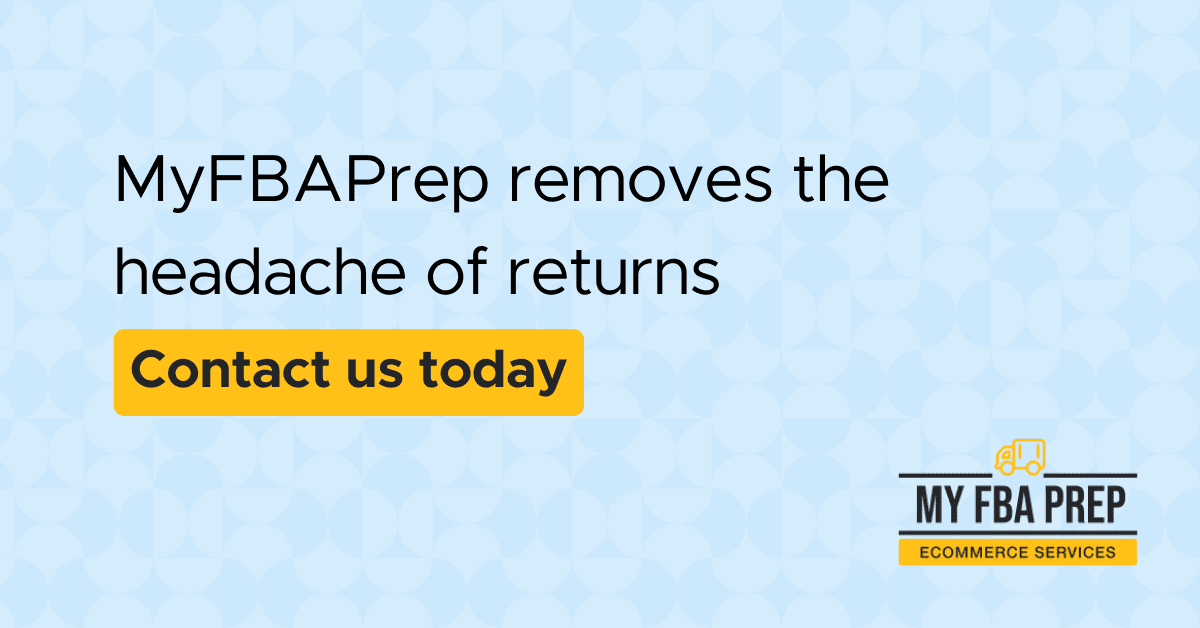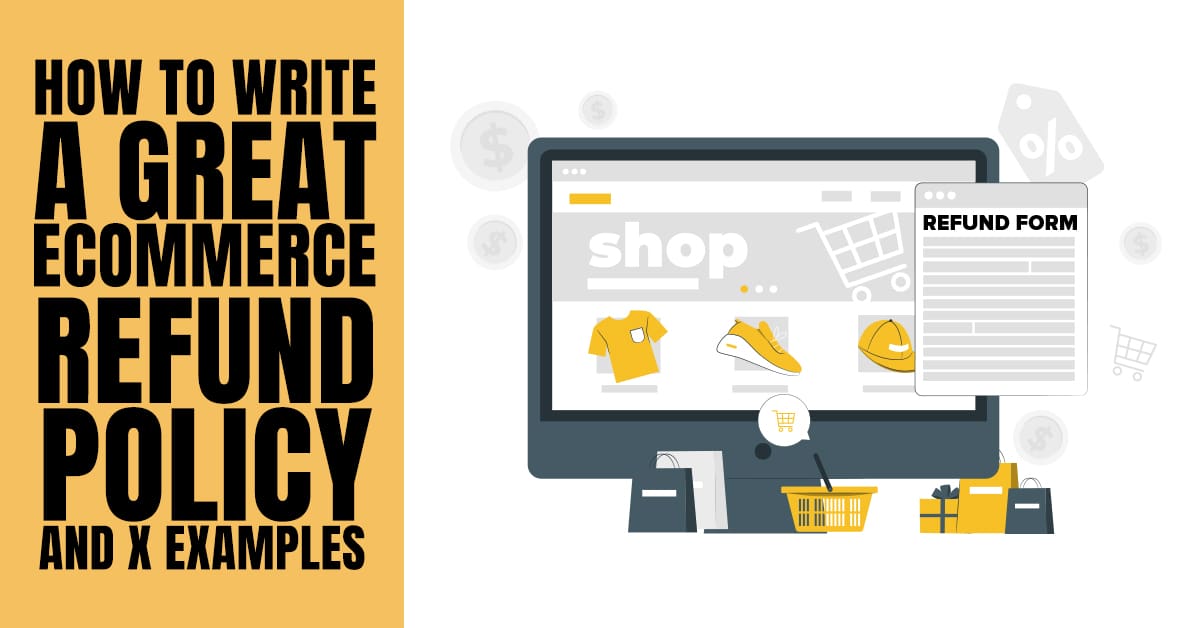
How to Write a Killer Return and Refund Policy

Imagine you’re standing in line at a store preparing to purchase an item and you have some doubts in the back of your mind. Perhaps you’re worried it won’t match the color scheme of your home, or maybe it’s an article of clothing that, once you try it on later, doesn’t flatter the way it did in the fitting room. As you prepare to check out, you ask the cashier about the return policy — specifically, about getting your money back. The clerk explains the policy, circling it on your receipt so you know what to do if you want a refund.
In eCommerce, customers have no opportunity for this type of conversation at checkout. As such, it’s important to ensure your returns and refund policies are clear and easy to find on your website. This critical piece of information can help you reduce returns, avoid refunds, and improve the customer experience.
While it may seem like a hassle to deal with returns and refunds, they’re an important part of doing business online. Even if you strive to provide top-notch products and excellent customer service, there will nevertheless be times when a customer wants to return a product or request a refund. When this occurs, your well-honed refund policy will be your lifesaver to navigate the process smoothly, and we’ll explain how to draft one that fills both you and your customers with confidence.
Why you need a strong refund policy
A refund policy outlines the rules for receiving refunds for purchased goods and/or services. It details the eligibility requirements for returns, what types of refunds are given, the time frame, and the return process, giving you and your team a rule book to follow when processing returns and refunds. This is especially important as you grow your business when you’ll likely begin to receive more returns as your sales increase, making a one-off or ad-hoc returns too cumbersome to manage.
The document lets customers know what to expect before they buy, which reduces the likelihood of dissatisfaction and avoids additional returns on your end. Clearly defining your policy and laying out the terms for customers in a concise manner act as insurance for your sales. For example, if you only offer refunds on regular-priced merchandise, customers know they can’t get their money back on sales items.
You should also aim to be fair and reasonable with your policy. It’s understandable you don’t want to give refunds for products that have been used or heavily worn, but you should also consider the unique circumstances of each request. If a customer has a legitimate complaint about something they’ve purchased, it’s in your company’s best interest to resolve the issue as quickly and amicably as possible.
How to write and launch an appealing return policy
Every return policy is unique to the individual business, and different products might require different eligibility terms. However, there are certain core elements that every document should include. Approach your writing thoughtfully and consider how to accommodate your and your customers’ best interests.
Determine a reasonable time frame
Firstly, choose a time frame during which your customers are eligible to request a refund. This can be whatever range you prefer, whether it’s 10 days or 365.
Decide when you’ll start the clock as well. Does the refund period open when the purchase has been completed (the date on the receipt), when the order was fulfilled (sent from your warehouse), or when the order has been delivered (as noted in the tracking information)?
You might opt to build your policy around a “try before you buy” approach, letting your customers use the product for a predetermined amount of time, such as one month, so they have the opportunity to change their minds with less hassle. These types of guarantees are attractive to shoppers, but they also benefit you.
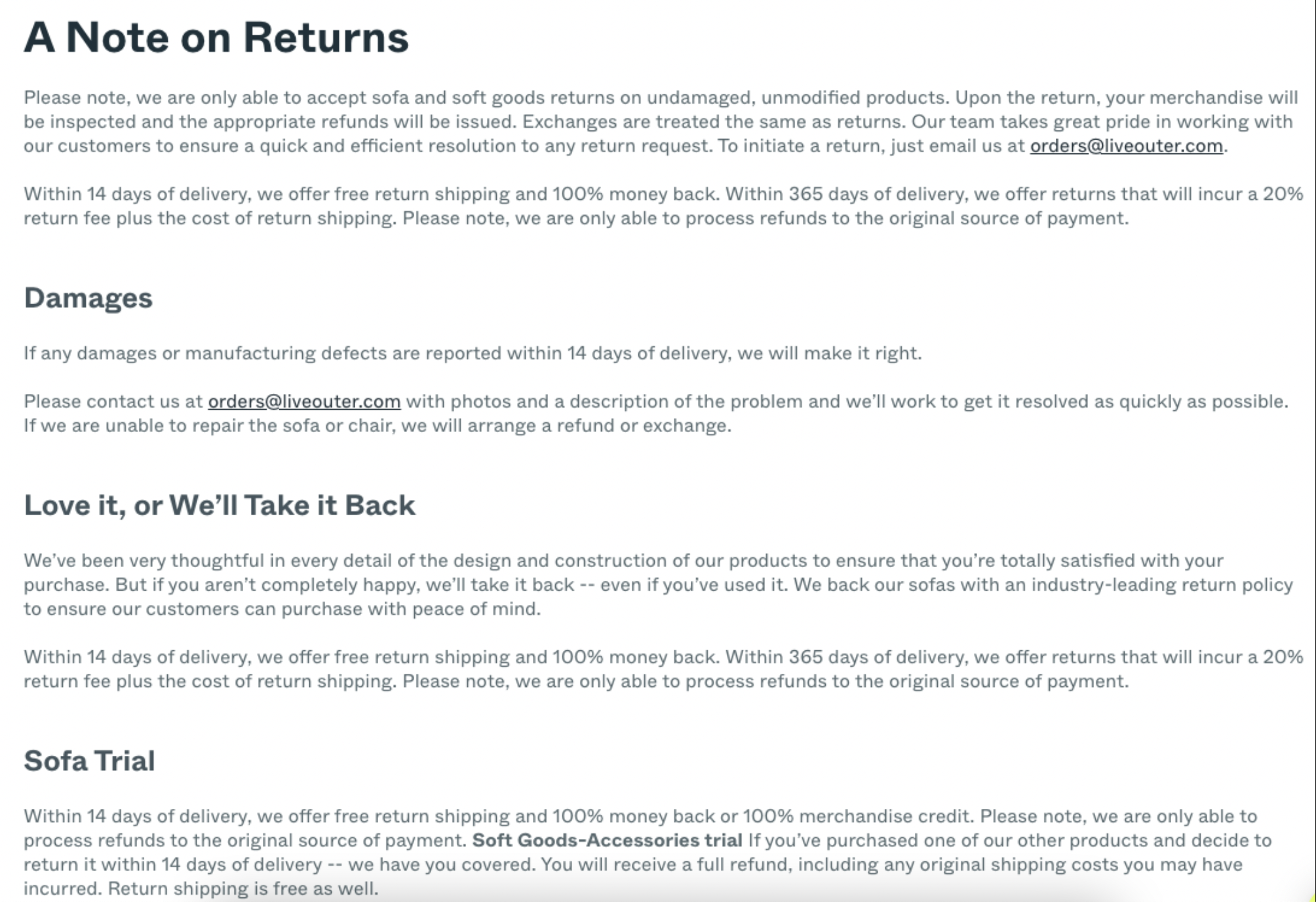
Source: Outer.com
Outer, for example, is a furniture company with a generous and unique return and refund policy: They’ll refund 100% of the cost of an order if the request comes within 14 days, but customers can receive an 80% refund up to one year after buying Outer products. This allows customers to test an item for an extended period of time. However, Outer doesn’t offer free returns outside of the 14-day window.
Longer time frames — those greater than the standard 10 to 14 days — allow your customers to become familiar with and fall in love with your products. When customers are not bound to a tight refund window, such as a 10-day limit, they may put off submitting a return, which could result in them missing it altogether.
Establish acceptable item conditions
Depending on your product type, you can have an array of requirements concerning the condition of items eligible for refunds. Regional laws where you do business can also dictate (or at least influence) these terms as well. For instance, in some countries, baby items like carriers, strollers, breast pumps, and larger toys can only be returned if the box is unopened.
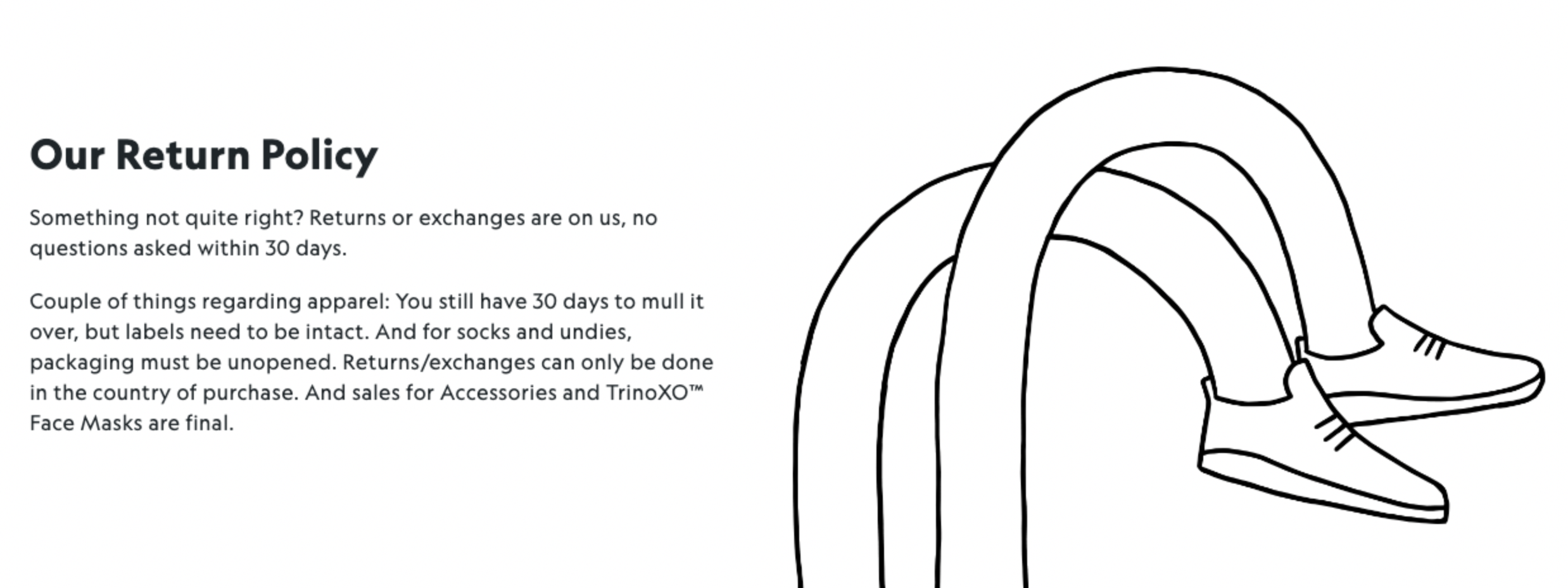
Source: Allbirds.com
If you adopt a “try before you buy” approach, you’ll need to be comfortable accepting items in varying degrees of a used condition, but that doesn’t exclude you from having strict requirements for the condition. For example, if you allow customers to test a product for 14 days, you can still require the item to be in a gently used, undamaged condition.
As a concrete example, Allbirds, a popular lifestyle company that sells footwear and other products, have different requirements for returns and refunds based on the products offered. They’ll happily take back any product within 30 days, but underwear and socks must be in unopened packaging; however, shoes can be worn.
List the steps for refunds to be processed
Once you’ve determined a time frame for refunds and the condition required for an item to be eligible for a return, detail the steps for the refund process.
Depending on your company and processes, you may have an online request form that customers can fill out, or buyers may need to contact you directly. The request may include:
- Proof of purchase (order number)
- Proof of condition (photos)
- Complaint or reason for refund request
Whether or not to offer free product returns is up to you, but there’s considerable evidence that free returns boost sales. While free returns will cut into your profits, a 2012 report demonstrated how free returns can increase sales by a whopping 357% — proving it’s a worthwhile investment.
The next step in offering returns is to verify the return package has shipped. Some large retailers like Amazon (particularly through FBA) simply wait for tracking to start before processing a refund, with funds deposited to the original form of payment within a few days. But many other retailers require the returned products to be delivered in acceptable condition before the refund is issued.
In some cases, returned products may only be fit to be used for parts, or you might be able to resell them at a discount with an “open box” label. Keep this in mind when you decide on the item conditions you’re willing to accept.
It goes without saying that defective products — that is, those with manufacturing issues or that arrived at their final destination damaged — should be refunded or replaced as quickly and seamlessly as possible.
Finally, you may choose to offer refunds on products without requiring your customer to send the item back (although this practice is less common).
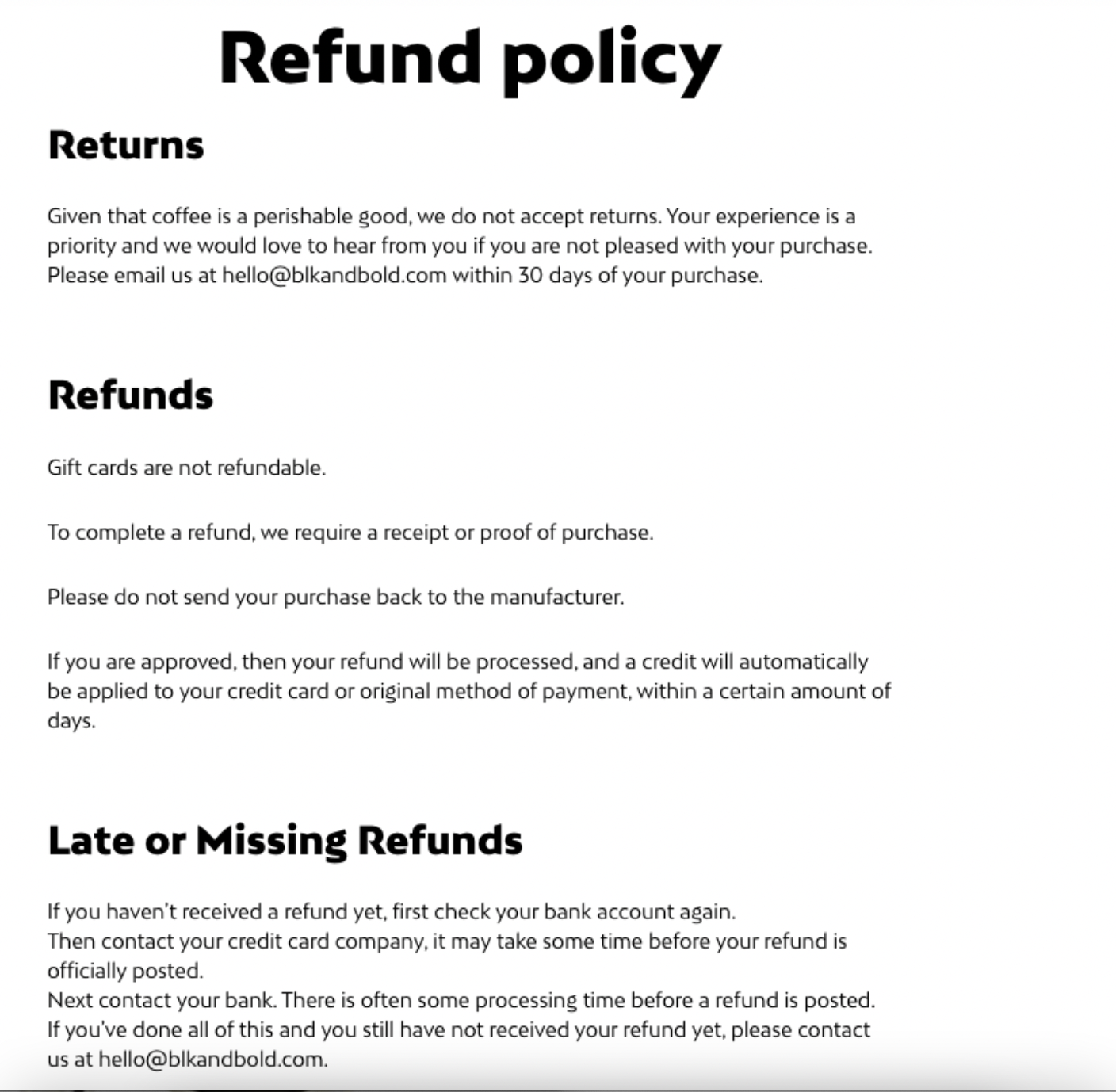
Source: blkandbold.com
BLK & Bold is a coffee and tea beverage company with a focus on supporting youth initiatives. They offer in-store and online purchasing options, including subscription programs, and customer satisfaction is a main focus for them. They’re committed to excellence in that regard, and it’s reflected in their refund policy: The company doesn’t require products to be returned. However, refund requests will only be processed within 30 days of purchase.
Clearly display your policy
Your returns and refund policy should be readily visible and easy for your customers to find. Some retailers have gotten creative to make it easy for shoppers to see. TenTree, for instance, includes their return policy directly on their product pages, located in a handy accordion that can expand. Although their policy is somewhat generic, costing customers a flat $10 within 30 days of purchase, its visibility, and simple language ensure zero confusion.
Employ a service to handle your returns
Services exist that can support your return and refund policy by handling every step of the process for you.
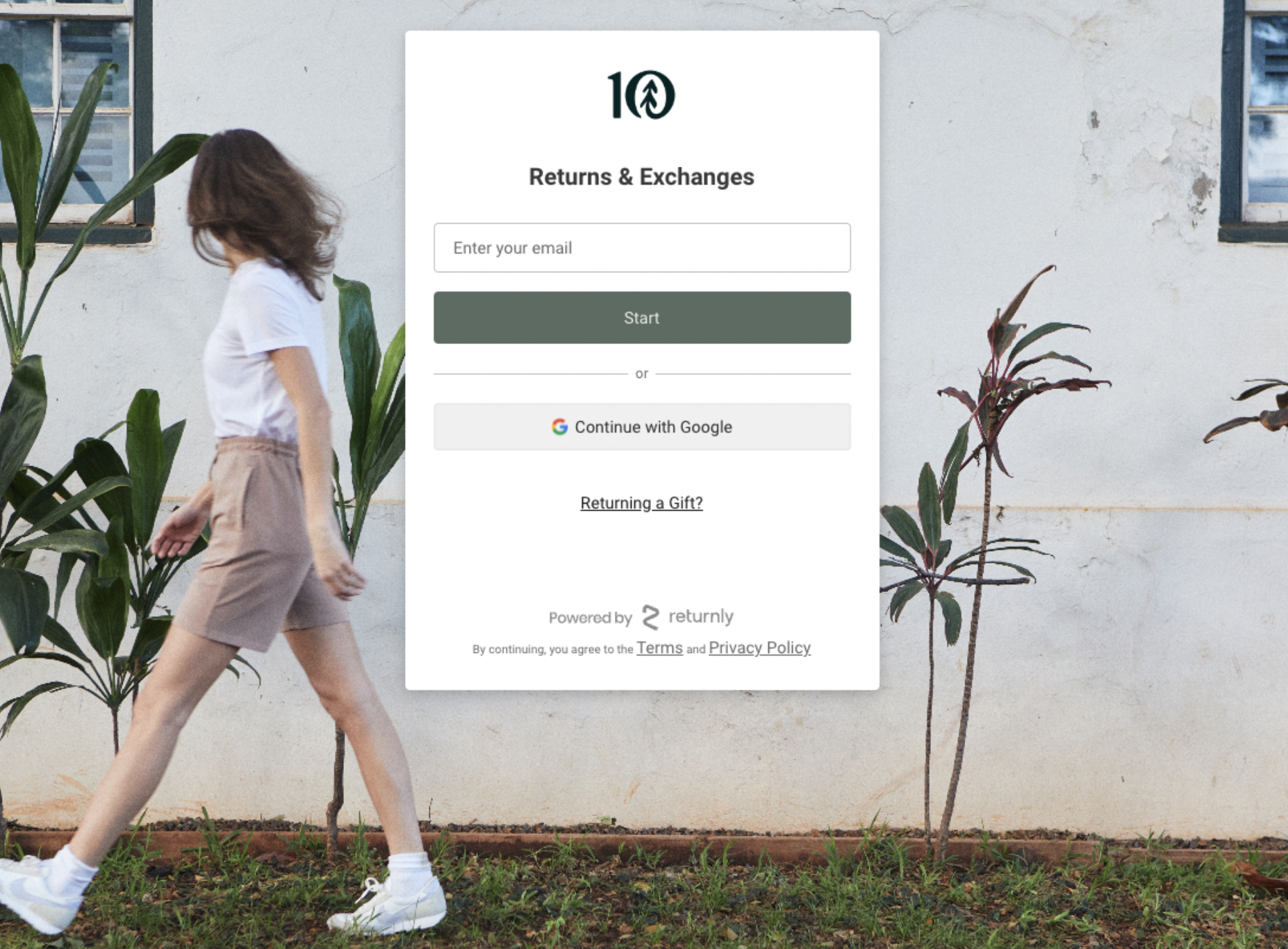
Source: TenTree.com
For example, TenTree (mentioned above) uses a platform called Returnly, while Allbirds uses Loop. Meanwhile, Amazon sellers who use Fulfillment by Amazon (FBA) can rely on FBA to take care of all aspects of customer service, including returns and refunds.
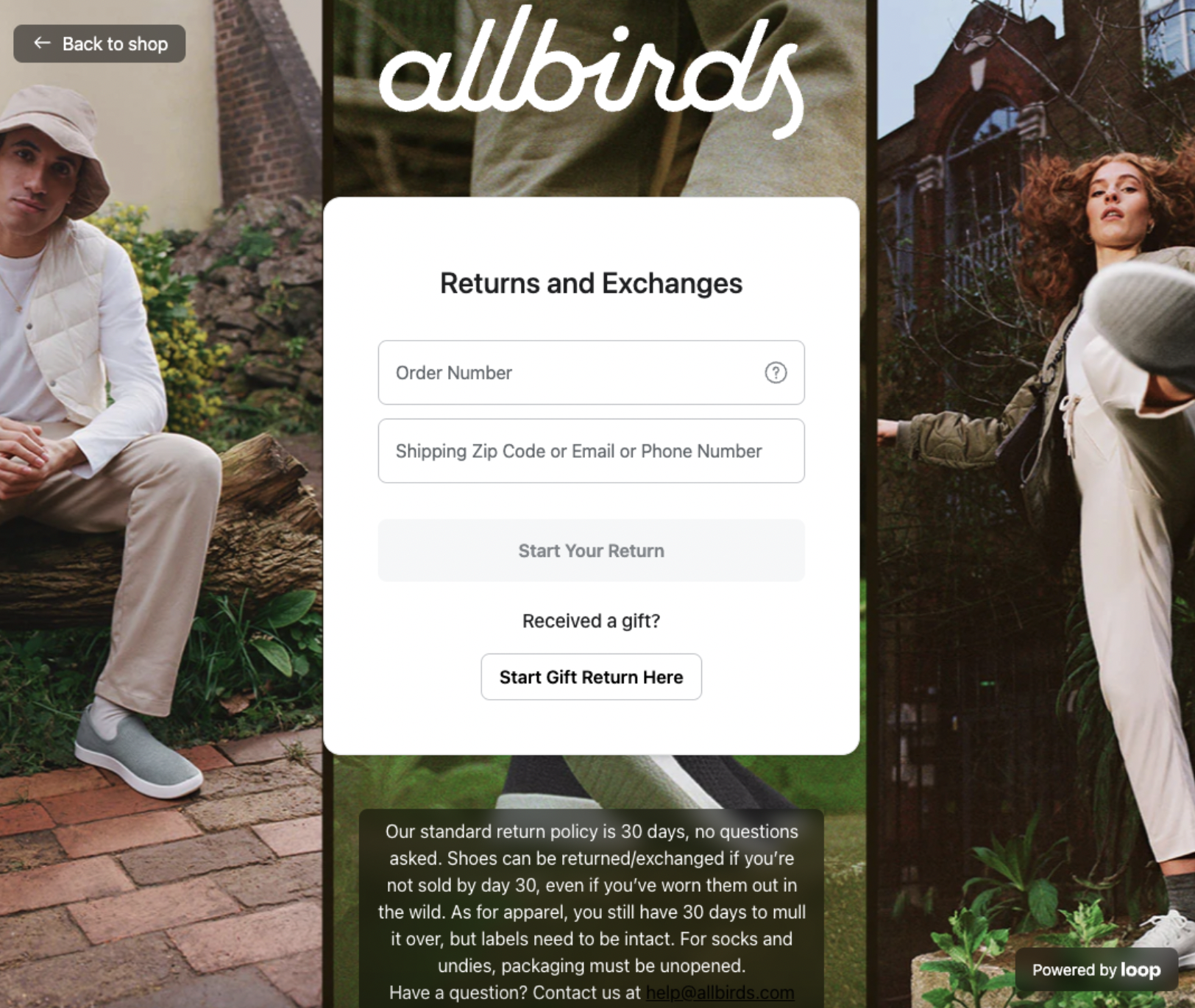
Source: Allbirds.com
These are but a few services that manage the reverse logistics of returns and refunds to ensure seamless customer experiences.
Choose between a refund or store credit
Another important decision you’ll have to make is whether to offer refunds or store credit for returned items.
One advantage of refunds is that customers can choose how they want to handle the returned item. This is appealing to buyers who are unhappy with the product or who changed their mind about the purchase.
On the other hand, offering store credit allows consumers to purchase a different item from your store, which is an effective way to retain their business. It can also be less burdensome administratively for your business, as you don’t have to process a refund.
You can make refund methods time-sensitive, such as offering a full refund within X days, or they can vary by product — for example, offering only store credit when a product was purchased on sale. However you decide to proceed, communicate whether items are eligible for refunds and/or store credit (and if any items will be labeled as “Final Sale”).
Keep the language simple and to the point
The language in your refund policy must be clear, concise, and easy to understand. This helps ensure customers understand their rights and options when it comes to returning a product or requesting a refund. If the policy language is too complex or difficult to comprehend, it can cause confusion and frustration for customers, which could lead to negative experiences and potentially damage your reputation as a merchant.
By implementing clear verbiage, you effectively communicate your policy and resolve customer issues in a timely and efficient manner — often before they purchase, which reduces the number of refund requests you receive. Additionally, an open and simplistic refund policy can build trust and confidence in your company by demonstrating transparency and fairness in your dealings with customers.
Disclose any associated fees
Returns can be a necessary but expensive evil in an eCommerce business. With shipping costs rising around the world, it’s understandable some merchants choose not to offer free returns on products. If you decide to follow suit, it’s imperative you outline any fees associated with a return.
Two companies we’ve previously mentioned clearly define the costs accompanying any returns:
- TenTree has a flat $10 rate on all returns to cover the cost of postage.
- Outer offers free returns within 14 days. Past that date and up to 365 days post-purchase, they require customers to cover the cost of return shipping.
In general, the cost of returns is subtracted from the total refund offered.
Leverage tools to generate a policy for you
Crafting a full returns and refund policy can be overwhelming, and if you dislike writing, it can be downright unpleasant.
MyFBAPrep offers a DIY solution to generate your refund policy that takes the heavy lifting out of policy creation. The Refund Policy Generator takes only minutes and provides an easy-to-read policy that clearly details your company’s approach to returns and refunds.
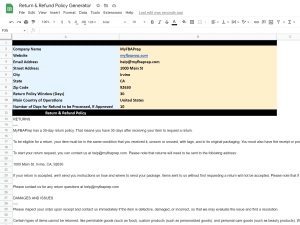
Download it below!
Answer the form above, fill out your company information, and make any necessary edits. From there, you can copy and paste the generated policy onto your eCommerce store and begin promoting.
*Note that this is not professional legal council. Every store’s policy will be unique, so please review the generated policy before adding it to your store.
Promote your policy
A strong refund policy also provides a great marketing opportunity for your business. Show off your generous refund policy to build trust with prospective customers. As long as you adhere to it, your policy can breed customer loyalty by showing them you’ll do what it takes to make things right for each issue.
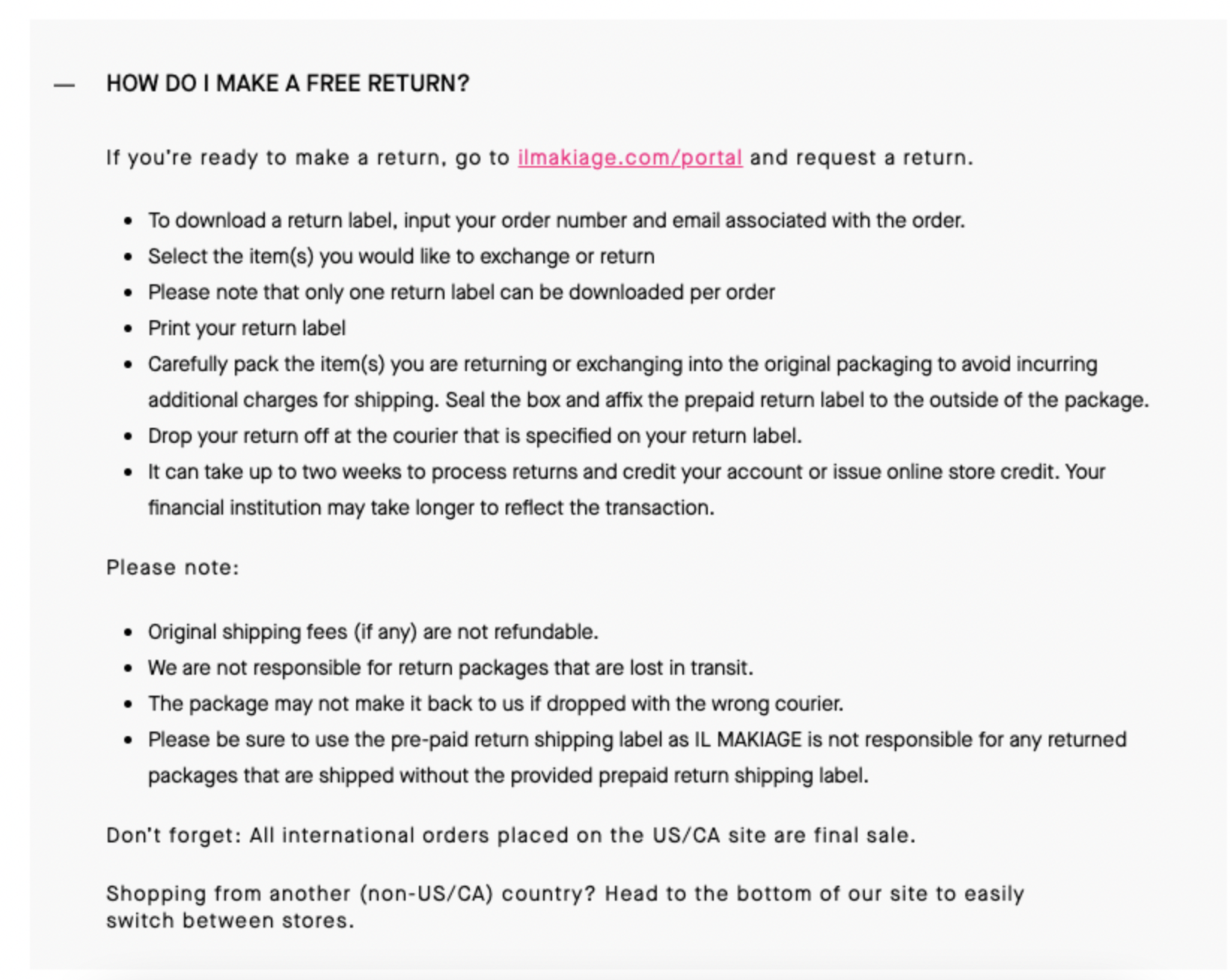
Source: IlMakiage.com
Take Il Makiage, an eCommerce brand that sells cosmetics and skincare products, for example, much of their marketing leans on their Try Before You Buy approach while also highlighting their unique “shade finder” tool and other products. They allow customers to use the product for up to 14 days, and at any time during that period, dissatisfied customers may request a refund — no questions asked.
Not sure where to begin? Keep the following key tips in mind:
- Include your refund policy on product pages.
- Highlight your returns and refunds policy on your home page.
- Work your refund policy into your marketing messages.
- Link to your returns and refunds policy in every post-purchase communication, from the success page to your retargeting emails.
Wrapping up — Create an awesome return and refund policy to set expectations
Having a clear and concise refund policy not only protects your business but also builds trust and credibility within your customer base. It’s also a fantastic marketing tool for your business when displayed strategically.
It shows potential customers you’re a professional and reliable company that stands behind its products. A generous refund policy also encourages customers to shop with confidence, knowing they have recourse if they’re dissatisfied with their purchase.



